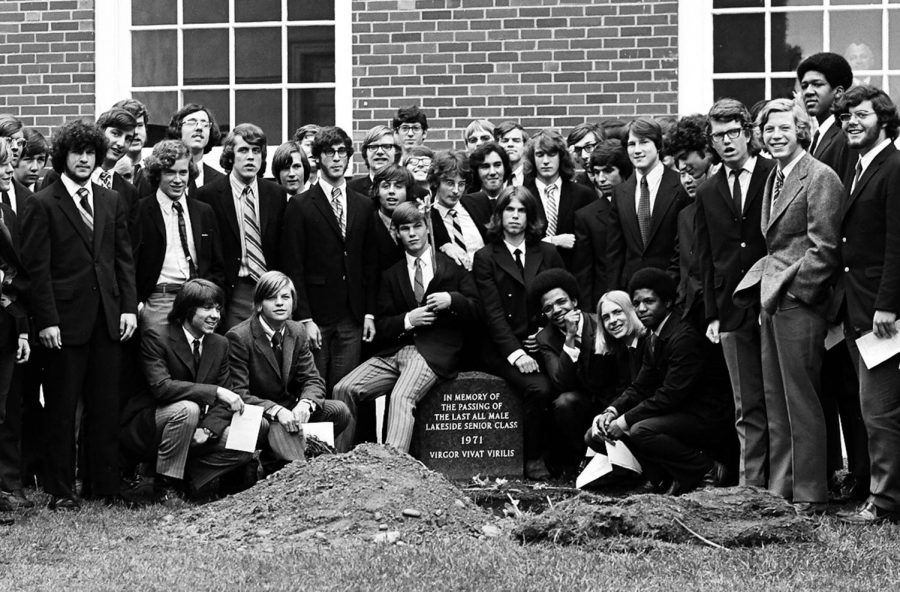Girl Meets Lakeside: A History of Co-Education
“Virgor Vivat Virilus:” the final, although ironically misspelled, words of Lakeside’s last all-male class. This message, translating to “long live manly vigor,” sits gravely on a tombstone outside of the Pigott Arts Center. It was buried there by the 1971 graduates, as a memorial for Lakeside’s multiple decades of being a boys-only institution. Similarly, a thought-provoking history of co-education is tucked away within Lakeside’s past, rarely given a second glance.
In its origin, Lakeside School was founded in 1919 as Moran-Lakeside School, a feeder school for Moran Upper School on Bainbridge Island. Although both were officially all-boys institutions, Moran-Lakeside had two girls in attendance: Mary Moran, the daughter of founder Frank Moran, and her best friend, Dorothy Moorhouse. After these two graduated, the school went back to being solely male, and emphasized masculinity in its education.
The early twenties marked the departure of Lakeside’s last female faculty members for almost three decades. This shift meant that the school had become dominated by male students, staff, and board members alike, creating an undeniable culture of masculinity that manifested in a variety of ways. In 1925, Lakeside began a tradition of Gold Star Awards. Each point of the star represented a valued quality in Lakeside students: “athletics” was included along with “scholarship,” “fellowship,” “character,” and “effort,” stressing the importance of stereotypical male traits such as strength and vigor. The school even required that all students involved in athletics take on the “manly sport” of boxing by 1940. In addition, certain school clubs were introduced to encourage building male character. During the thirties, Lakeside formed the Rifle Club, with its members using the attic of Bliss Hall as a firing range. Although these attempts to cultivate such a male-oriented community were efficient and effective, the presence of females on campus was inevitable—even if it was not in an educational setting.
After approval in 1955, Lakeside’s first-ever mixer with St. Nicholas, their all-girls sister school, occurred. The theme was Campaign Capers, in honor of the election year, and the event gave a chance for students from both schools to practice their social skills with those of the opposite sex. St. Nicholas also continued to forge a connection with Lakeside by cheering at various sports games, along with Helen Bush School for Girls. A few years following, an opportunity finally arose for women to hold academic positions at Lakeside.

During July of 1958, math teacher Jean Lambert helped Lakeside host its first summer science and math camp for both boys and girls. In 1967, co-education finally returned to Lakeside during the school year. St. Nicholas student Karin Williams ’69 was permitted to take advanced math and science courses at Lakeside due to lack of an equivalence at St. Nicholas. She, however, would be the only exception, as the board was still explicitly against co-education. Minutes from their meeting to decide upon her enrollment read that “the experiment would not set a precedent.”
As cultural change spread throughout the nation, St. Nicholas raced to keep up. In the late ’60s and early ’70s, seniors were permitted to smoke in certain areas, students could go off campus, and the requirement of uniforms was terminated. However, these shifts were not progressive enough to keep St. Nicholas socially relevant. Their enrollment was lacking, and funding became a prominent issue. By the time the New Year celebrations of 1970 had ended, St. Nicholas’s merger with Lakeside was approved by trustees. The last all-male class finished out its year, and the Middle School took over St. Nicholas’s campus. Co-education had officially, and historically, implemented its legacy at Lakeside.
Just as the bullet holes in Bliss’s ceiling from Rifle Club practice are still visible 60 years later, Lakeside’s male-dominated culture has left lasting impacts on our community today. Remnants of gender division are apparent in sports teams, electives, clubs, extracurriculars, and student interaction. Although Lakeside strives to uphold its values of diversity and inclusion, there is still much work to be done. With more and more people recognizing that gender does not conform to a binary, non-inclusive locker rooms and gendered language are becoming rightfully outdated. Student groups believe that the school has a responsibility to change its practices and keep up with this ongoing social evolution. Otherwise, Lakeside will fall behind, and may find itself following a bit too closely in St. Nicholas’s footsteps.
Today is gonna be the day that we talk about Estelle Lee,
She's the managing editor, planting the journalism seed.
I'm sure you've heard her name,...

